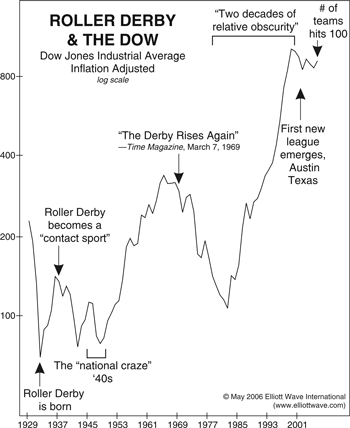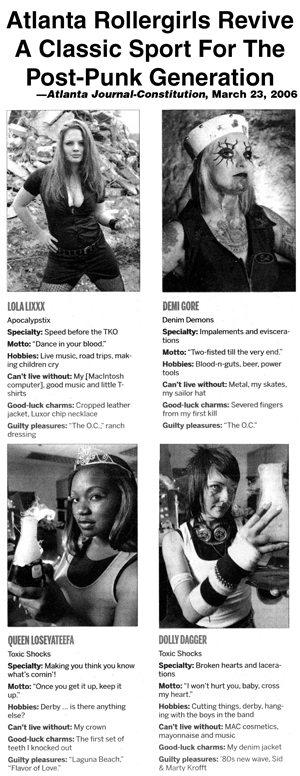Here’s another extraordinary popular distraction that is now striking the same bearish chord with the public that it hit back in the late 1960s: Roller Derby. Compare this headline from the March 7 1969 issue of Time magazine:
The Derby Rises Again
Jerry Seltzer, the president of Bay Promotions, Inc., in Oakland, Calif., is promoting the Big Comeback of that riot on roller skates called the Roller Derby.
To this one from a recent issue of Staten Island Advance:
Roller Derby’s Time Comes Around Again
This chart shows how the sport gains traction with fans when the Dow is down or rolling over and goes into hibernation when it rises.

Roller Derby did survive the bull market of the 1950s and 1960s, but it tends to re-emerge as the trend in social mood shifts from up to down, and it thrives in bear markets. It was first conceived at the end of Supercycle (IV) in 1932 as an endurance sport like the dance marathons of the same era by promoter Leo Seltzer. The contact was added near the top of Cycle I, probably after the March 1937 peak, when, legend has it, “sportswriter Damon Runyon suggests more physical contact in a conversation with Leo Seltzer.” (We’re guessing that it was after the peak because some histories place the moment in 1938.) It’s heyday was the late 1940s when Time says it became “a national craze.” In 1949 as Supercycle IV was ending (in inflation-adjusted terms), a short movie about the sport was nominated for an Academy Award. After roller derby’s 1969 revival (Time article hit four months after the peak of 1968), a full length feature starring Raquel Welch, Kansas City Bomber, came out (1972). The bear market ended in 1974 and almost coincident with that low an Internet history says “fans deserted the arenas.” According to Wikipedia, “two decades of relative obscurity” followed. This is completely consistent with our contention that roller derby is a bear market sport as these were the best years of the bull market (Cycle V). The latest revival started in 2001, the second year of the current bear market.
There are also several reasons to believe that sports’ newly rising renown portends a deeper decline in social mood than that of the 1970s. These include the dominance of female performers/athletes, the sports grass roots appeal and the downright ghoulish personas assumed by participants. All three aspects are captured in this April 26 article in The Christian Science Monitor:
In Roller Derby's Revival, Women Elbow to the Fore
Seventy years after men and women strapped on skates and took to wooden tracks, speeding down banks and blocking opponents in a new sport named roller derby, the game - and its rough-and-tumble spirit - is back. Make no mistake, this is a high-contact sport. In its latest incarnation, it's all women. By day, these are lawyers, mothers, students, artists, bartenders, and businesswomen. But they wear bruises and scars from the battles they fight at night, as derby dames with names like Val Capone, Elle Destructo, or Ivana Krushya.
The first of these all-women leagues emerged in 2001 in Austin, Texas. Since then, dozens of amateur leagues have sprouted up across the country. The number of teams in various stages of formation has doubled from last year, to more than 100, according to the Women's Flat Track Derby Association.
As we said back in the 1996 quote at the top of this page, we cannot necessarily identify what was to going to come along to fill the public demand for more bearish sports fare, but roller derby certainly fits the bill. We never imagined, for instance, that an exclusively female contact sport would rise to the top of the list of fast-growth sports, but given our forecast regarding the role of women in the next bear market (see past entries including those of April 12, January 17 and October 11), it makes perfect sense. Another trait that makes roller derby look like a sport of the future is the working class nature of its popularity. From virtual non-existance at the end of the bull market in 2000, roller derby has “undergone a massive grassroots revival, with numerous all-women, amateur leagues being created around the country.” As the article above notes, the growth has clearly accelerated in recent months. Then there is the “alt-culture edge.” Here’s a few of stars of the Atlanta league and their profiles from the local paper.

DemiGore? Queen Loseyateefa? It sounds like professional wrestling, but everyone connected with the sport says it’s no hoax. “There's no planning what's going to go down. It's just the raw game.” With the resulting contact and the assumption of their dark roller derby personas, participants “vent life's aggressions and frustrations.” In a bear market, the volume and strength of these issues is bound to compound. As it does, look for roller derby to eat into the fan base of bull market sports like baseball and basketball.
|
